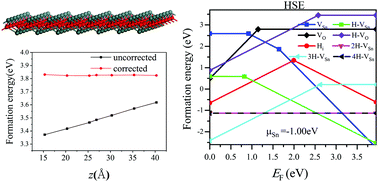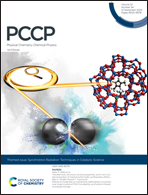The first-principles study of nH–VSn complex: impurity effects on p-type SnO monolayer†
Abstract
As a rare typical p-channel layered oxide semiconductor, two-dimensional tin monoxide has attracted great attention due to its wide promising applications in nano-electronics. Using the first-principles calculation, we studied the effects of multi-hydrogen–tin/oxygen vacancy complex impurities on the electronic properties of the p-type monolayer SnO. The calculation results indicated that O vacancy (VO) is a donor and Sn vacancy (VSn) acts as a double acceptor. VSn should be the source of p-type in undoped SnO in an O-rich environment. When hydrogen is introduced, the more stable nH–VSn (n = 1, 2, and 3) complex defects can be formed. These complex impurities can affect the p-type SnO monolayer in the following three main ways: (i) the p-type H–VSn compensates the deeper acceptor level of VSn and enhances the majority carrier mobility. (ii) The more stable 2H–VSn neutralizes the p-type dopant nature of VSn and H–VSn. (iii) The 3H–VSn converts the defect to be an n-type dopant. Our results indicated that limitation of hydrogen is necessary for the preparation of high-quality p-type two-dimensional SnO, as a small amount of hydrogen produces positive effect on p-type SnO; however, the higher concentration of hydrogen is destructive to the p-type character of monolayer SnO.



 Please wait while we load your content...
Please wait while we load your content...